
| Diggers Rest | 23 Miles 62 Chains 83 Links / 38.279 km | Clarkefield |
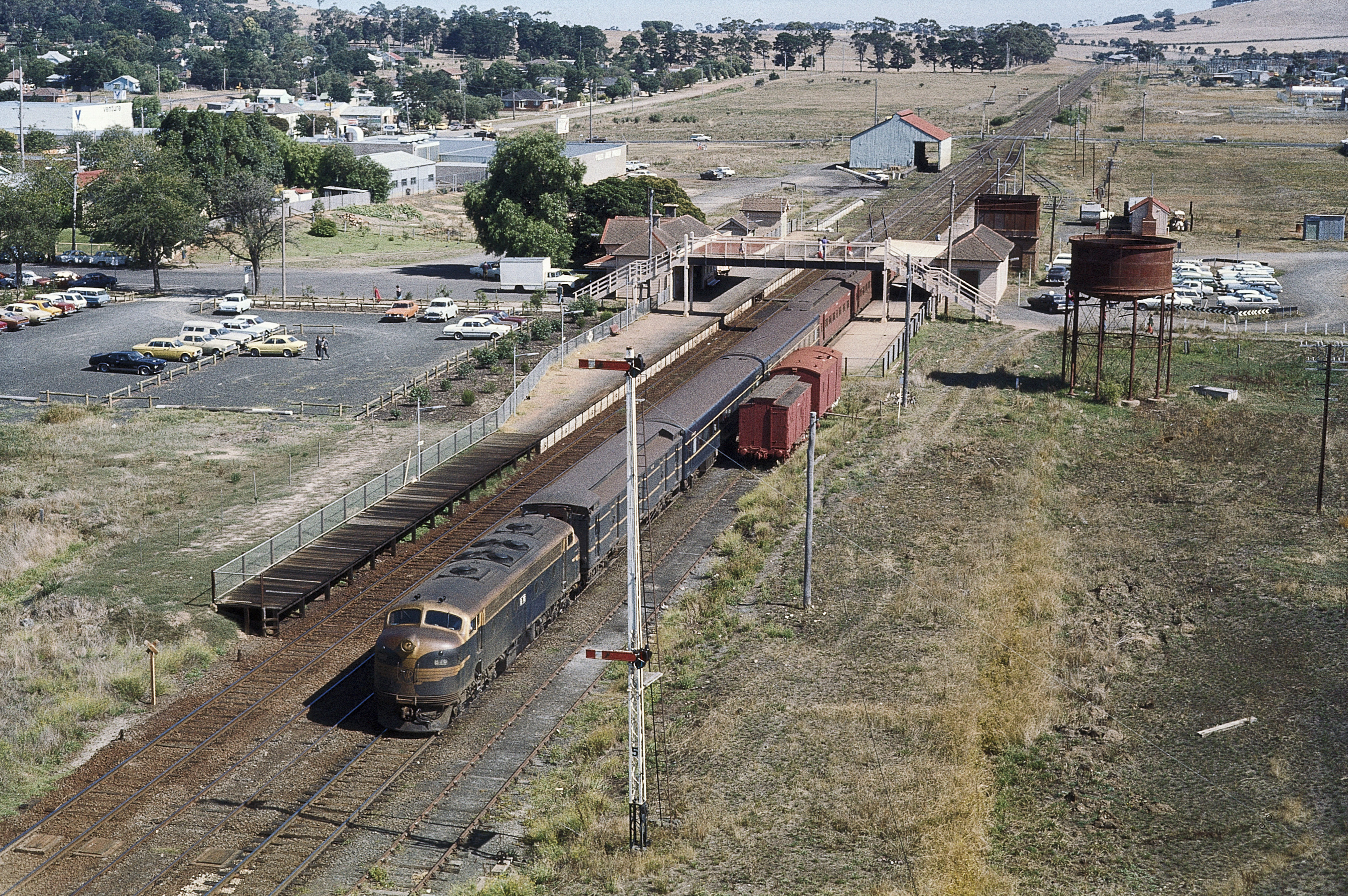
ABOVE: Viewed from the top of the grain silo, B79 heads the Down Swan Hill pass through Sunbury one sunny afternoon in March 1976. Note the co-acting Up Home signals on their tall lattice mast, and chaired rail in the siding with a pair of 4 wheel ''bug huts'' at the dead end. The grimy state of the loco was all too common, as was the lamentably low power to weight ratio of the average passenger train of this period. The surroundings are still semi-rural , a contrast to the current scene of supermarkets and cinemas with their associated car parks. Surprisingly enough, both the round and rectangular water tanks are still standing today amid a sea of 'tar and cement' but the ancient corrugated iron goods shed has vanished without trace. (Caption and photo courtesy Trevor Penn.)
Sunbury was the terminus of the first country section of the Victorian Railways to be opened in 1859, and the line was extended to the north two years later. The curious three track yard, dating from the earliest times and unique in Victoria, lasted until very recently. Another feature that lasted until recently was the lack of proper interlocking. An interlocking frame was provided in 1885 but this only worked signals. Interlocking the points with the signals only began in 1981 when one set of points was fitted with an Annett lock. Nearly all of the remaining main line points were similarly equipped over the next 12 years. Sunbury was fully interlocked, finally, in 1998 when an SSI was provided.
(Text from Andrew Waugh's 'Victorian Station Histories')

ABOVE: Sunbury station had a very interesting early history. From its opening in 1859, it was graced with a building of similar design to that at Williamstown. This was located on the Down side, and locomotive facilities including a turntable were provided on the Up side. After only 2 years of service, that station building was relocated to Woodend in 1861.
Although structural plans exist for the long goods shed on the Down side at the Down end, it is not known if this was actually built.
Much research is still needed to be done on this topic. To date, no photographs from that era have been located.
(The above image is a crop from a township survey plan, strangely dated 1865. [Full plan here]. Courtesy SLV)
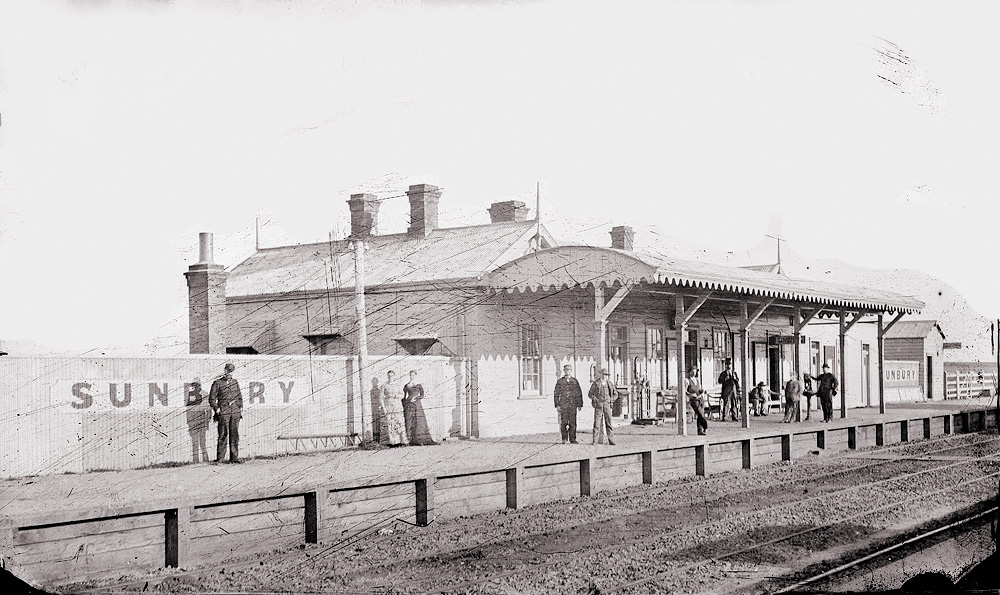
ABOVE: A very early view of the second station building, constructed in 1861. This was, (oddly for the line), built on a timber faced platform which was located on the opposite, (Up), side of the line, a little further to the North. This is the oldest known photograph of Sunbury station, we've located to date. Note the absence of any signal wires.
official VR photo, probably taken in the 1860s
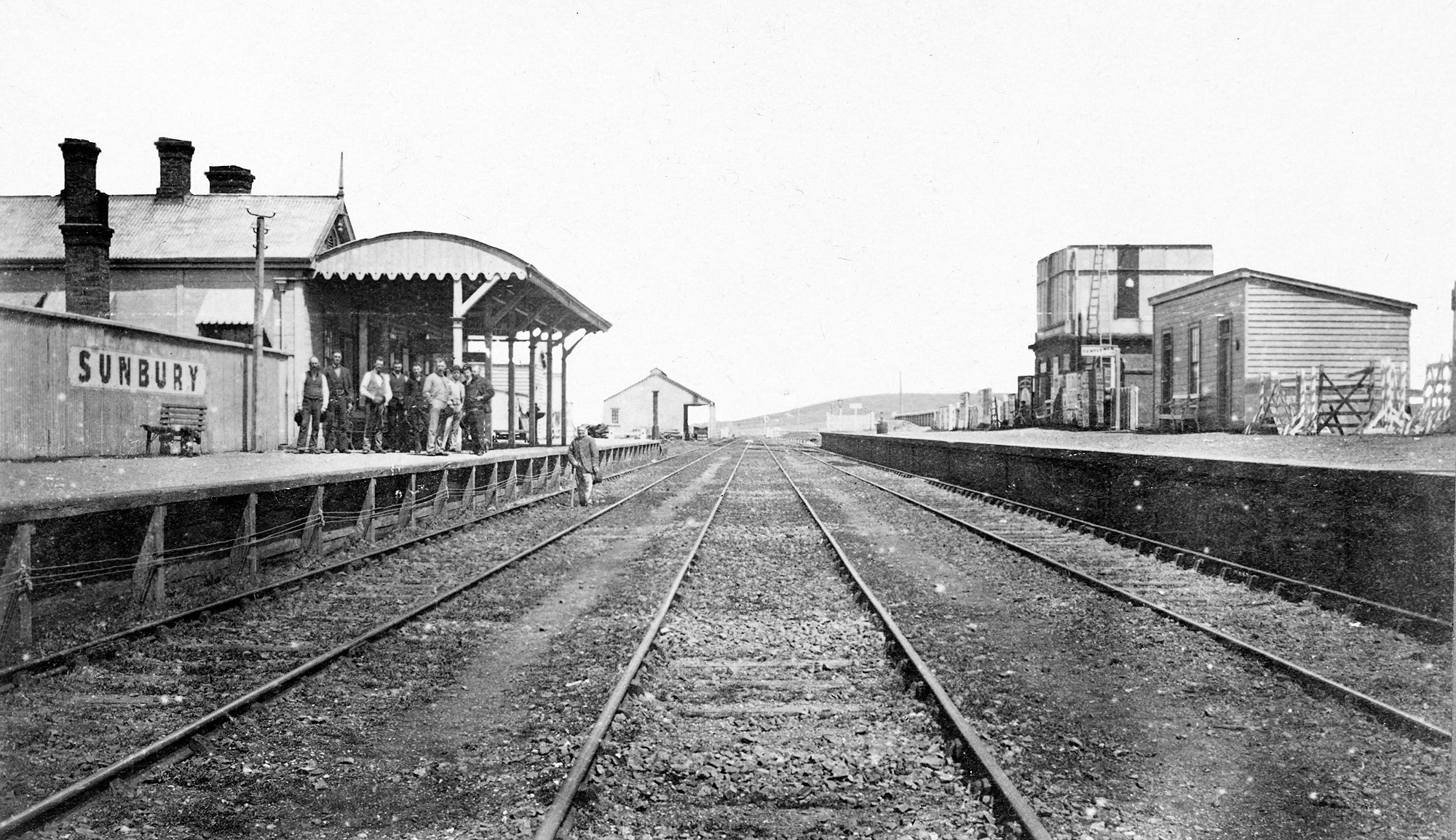
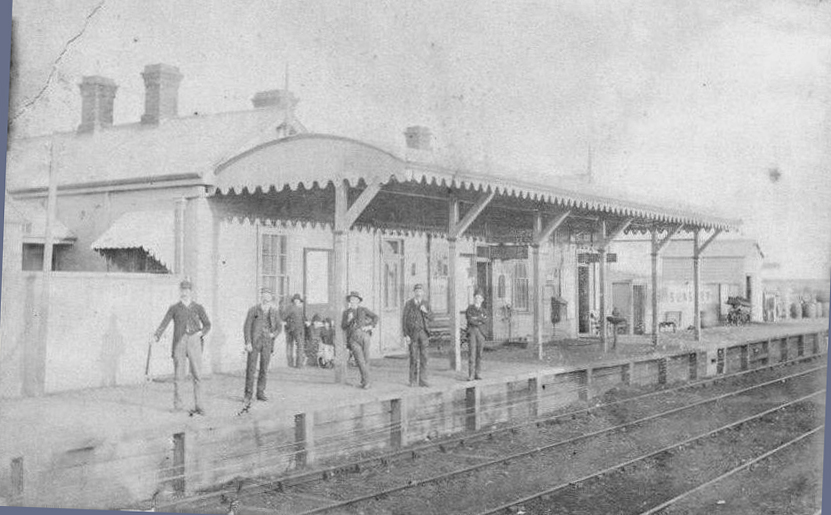
ABOVE: This image appears to date from a little later. An outbuilding is provided on the extreme left and is connected to the main building via a roofed walkway. (Lance Cross Collection)
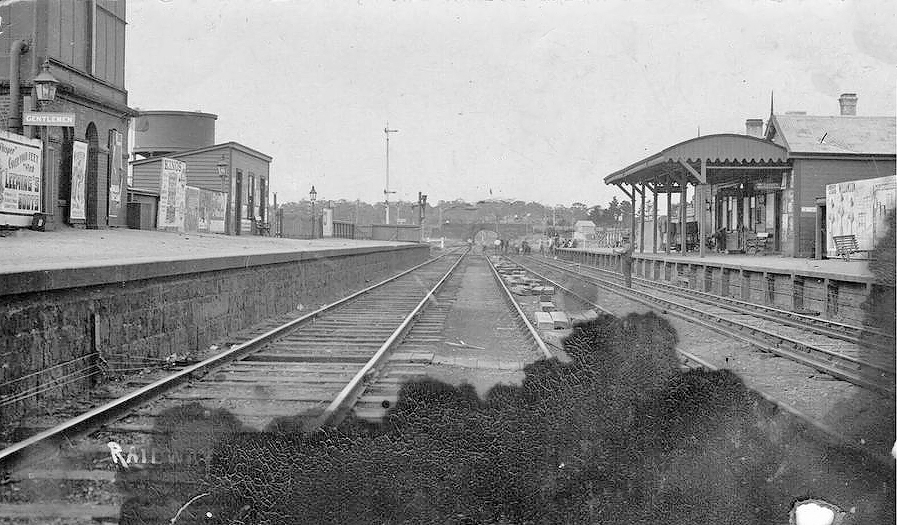
ABOVE: Looking North. Note that the the double headed rails on the down line have been replaced. (Lance Cross Collection).
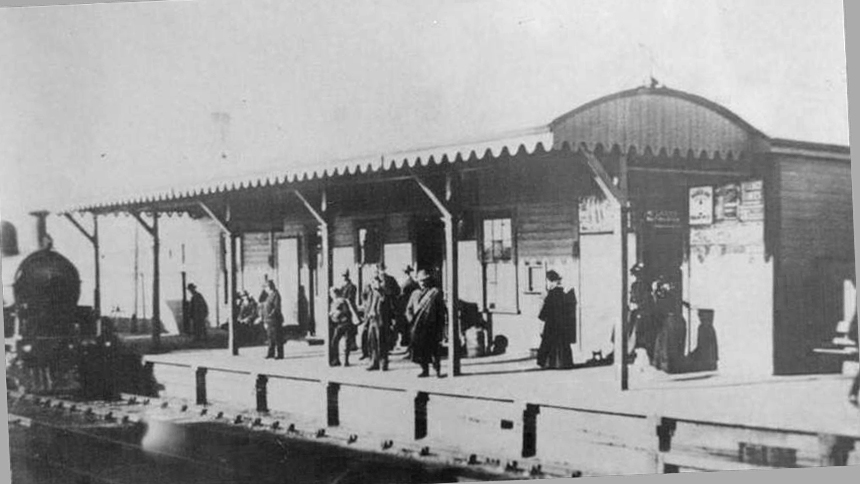
ABOVE: Looking North-East as an Up train enters the platform, prior to 1909.(Lance Cross Collection).
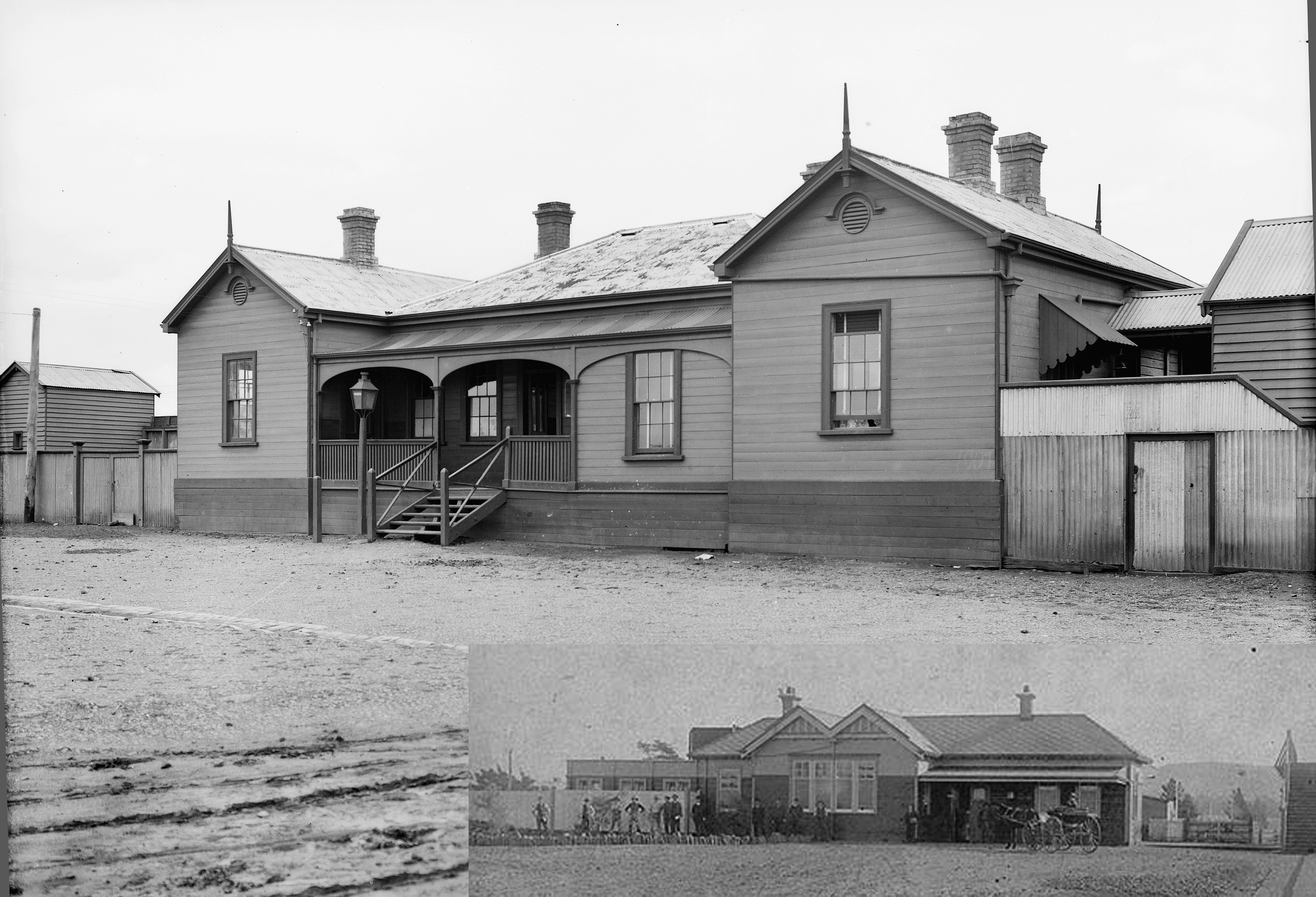
INSET: A similar perspective showing Sunbury's third station building c1920.
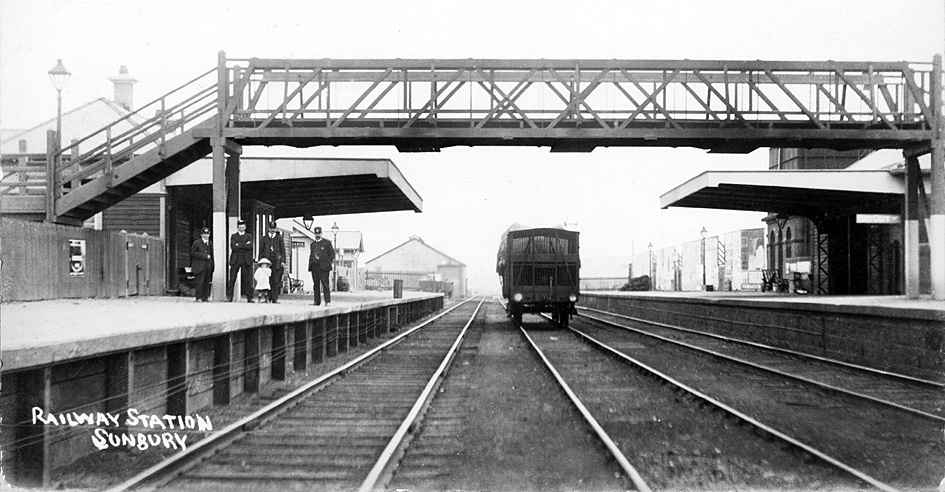
ABOVE: In 1909 the station buildings were replaced with those of the standard design for the era, which also included diamond patterned, asbestos shingled roofs. The main building on the up side survives to this day, still relatively intact. Note that by now, both of the main lines have been replaced with flat bottom rail. This view, looking towards Melbourne was taken c1910.
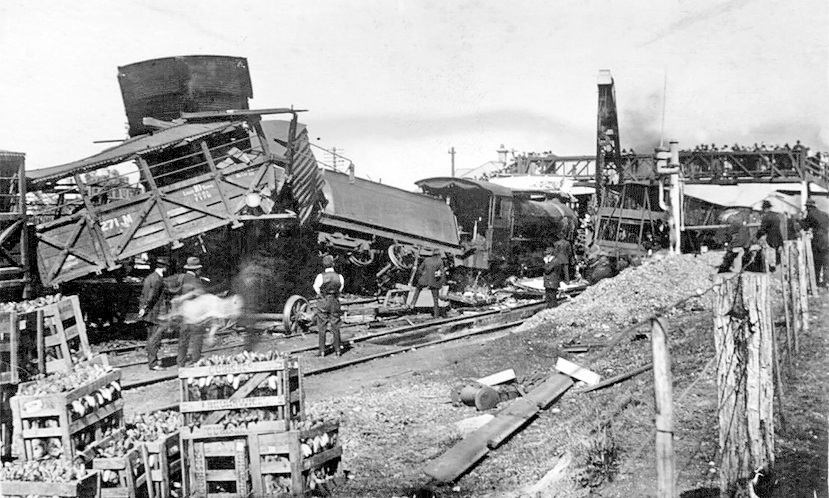
ABOVE: On April 16 1919 a special stock train from Pyramid Hill to Melbourne ran past a red signal and ran into the rear of a stationary up goods train. The departmental enquiry determined that the driver of the stock train was at fault for passing a signal at "danger" and that the signalman at Lancefield Junction was at fault for giving the stock special "line clear" to Sunbury.
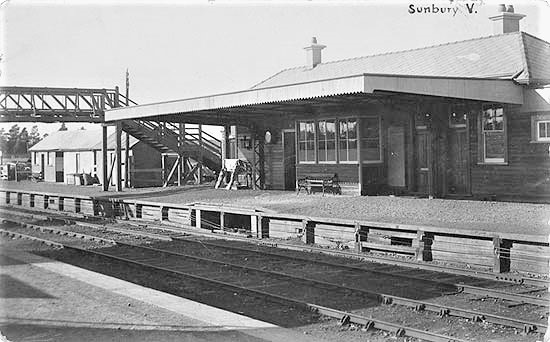
ABOVE: Looking North-East at the main station building, c1930. (Bruce McLean collection).
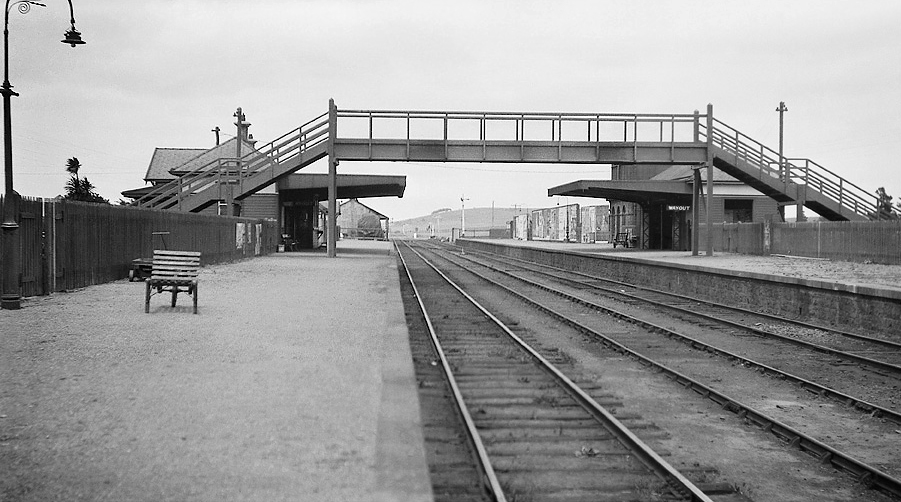
ABOVE: Looking towards Melbourne. It's hard to date this photo, but the gas light indicates it's pre-electric light at Sunbury. The footbridge has also had its timber trusses replaced with steel beams.
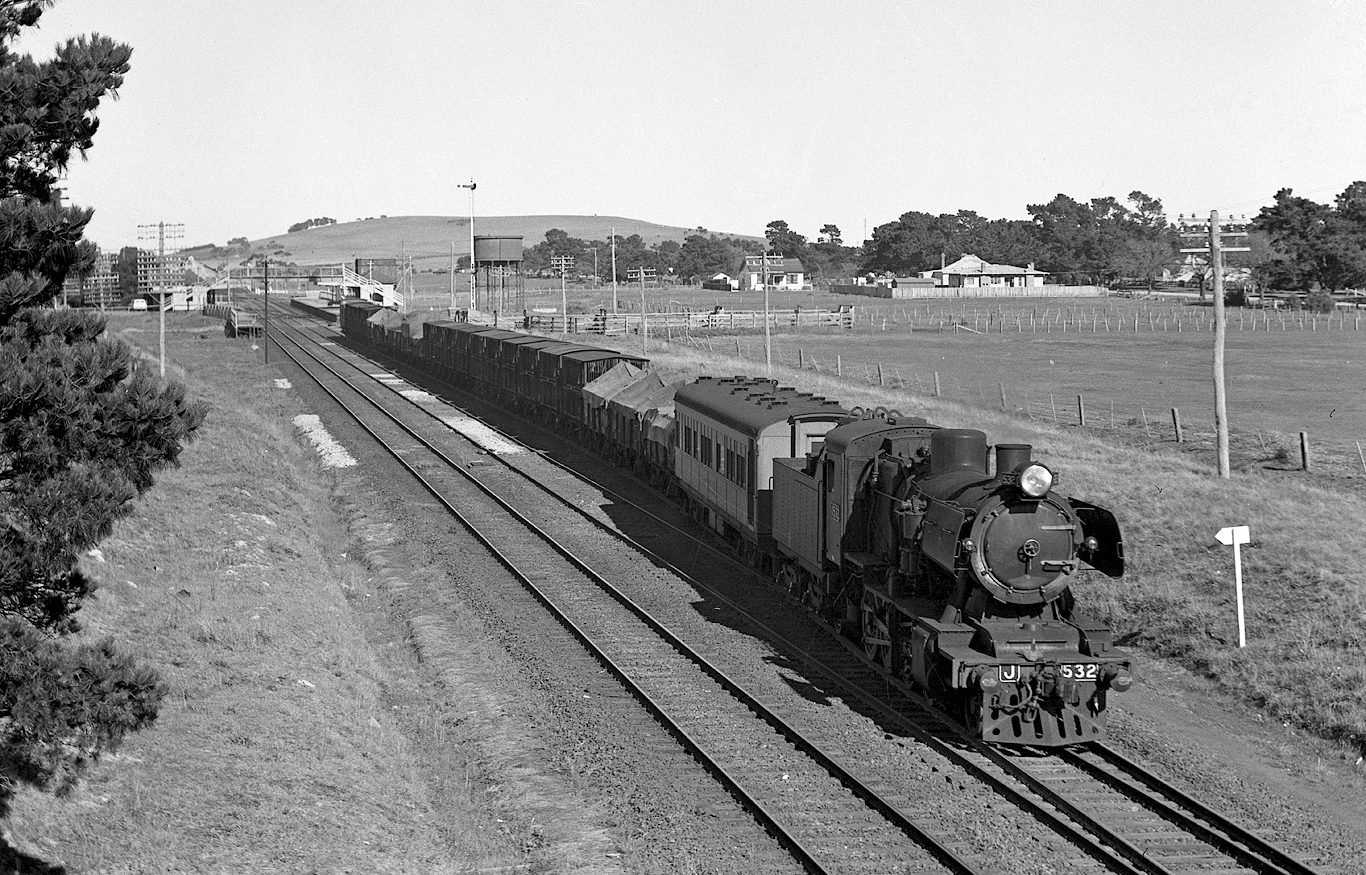
ABOVE: From Feb 18 1955 until April 2 1955, J 532 and 546 were doing daily Power Tests between Melb and Bendigo on the 10am down and 9-30am Up ex Bendigo return next day. Here one of the test trains is seen departing Sunbury.
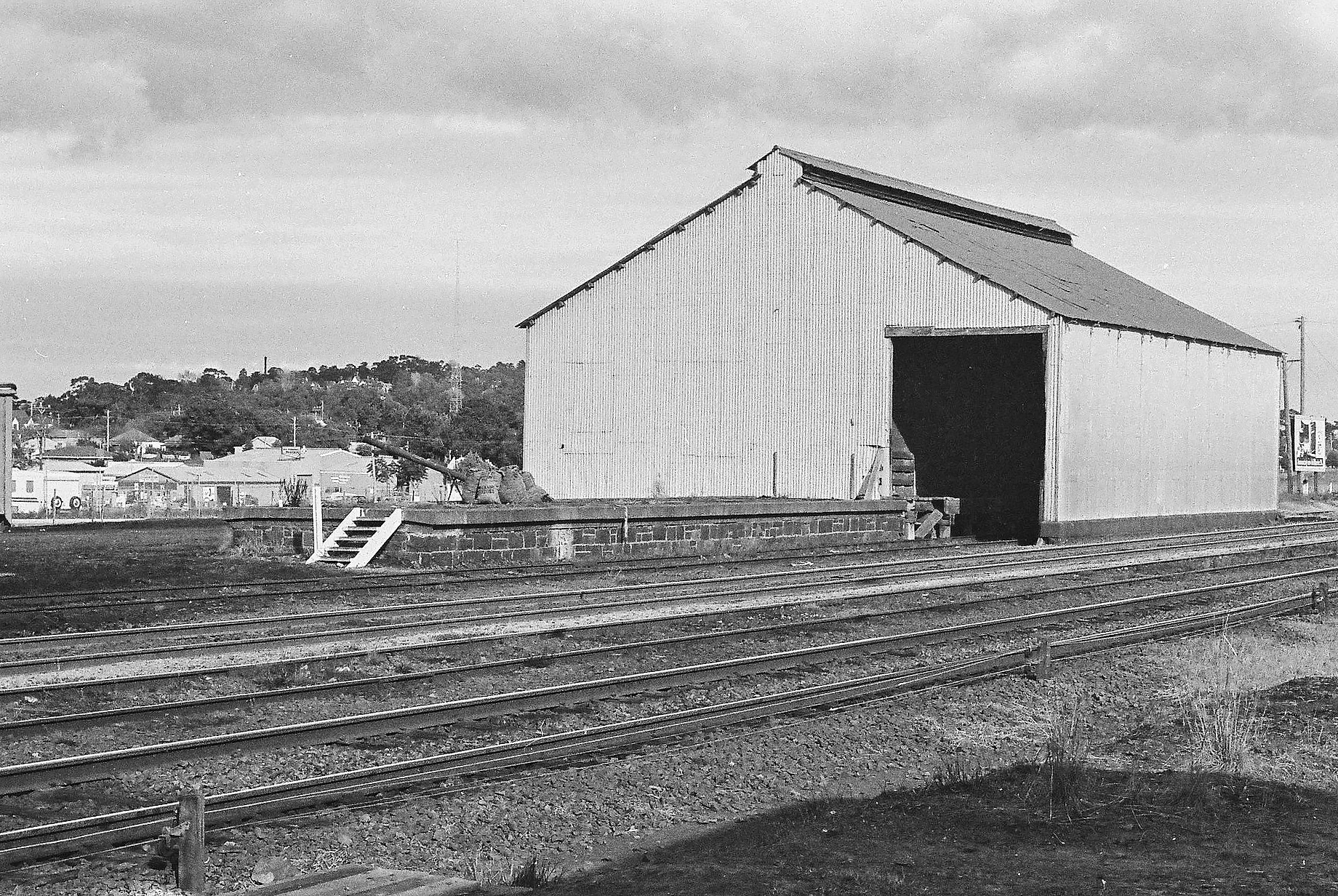
ABOVE: Sunbury goods shed looking towards melbourne. This shed may have dated from the line's opening, photo circa 1972 courtesy David Langley.
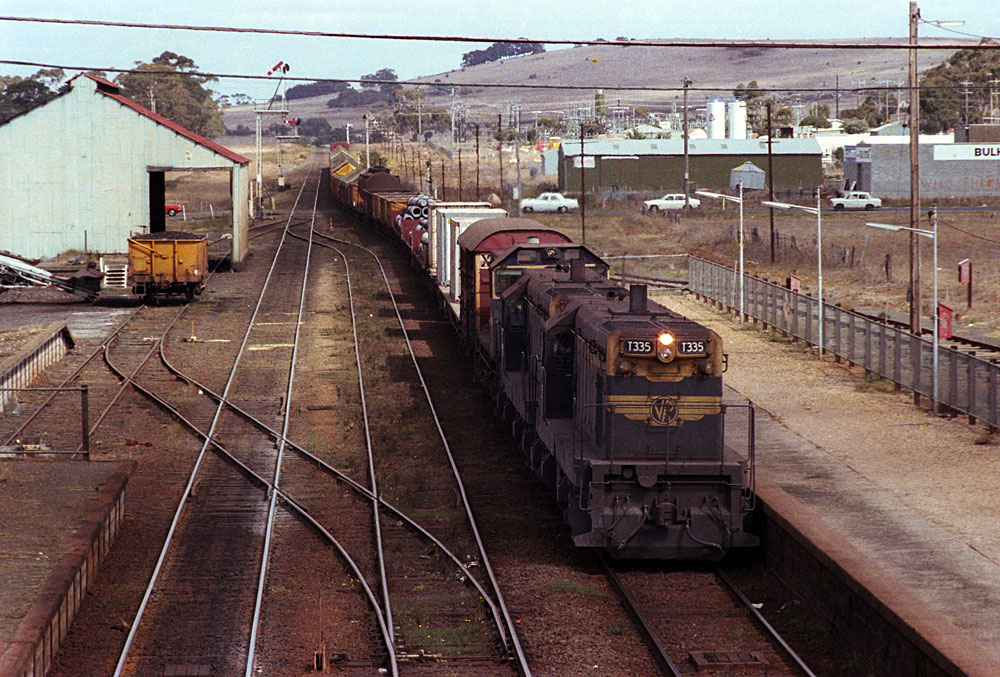
ABOVE & BELOW: T 336 - T 335 - Y 160 on a Down Bendigo goods arrives Sunbury. April 5 1980.
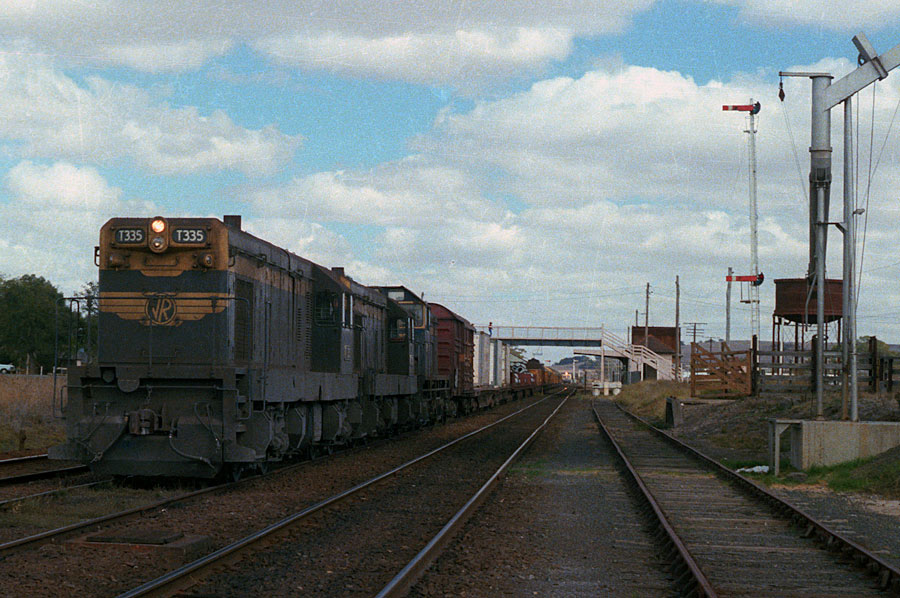
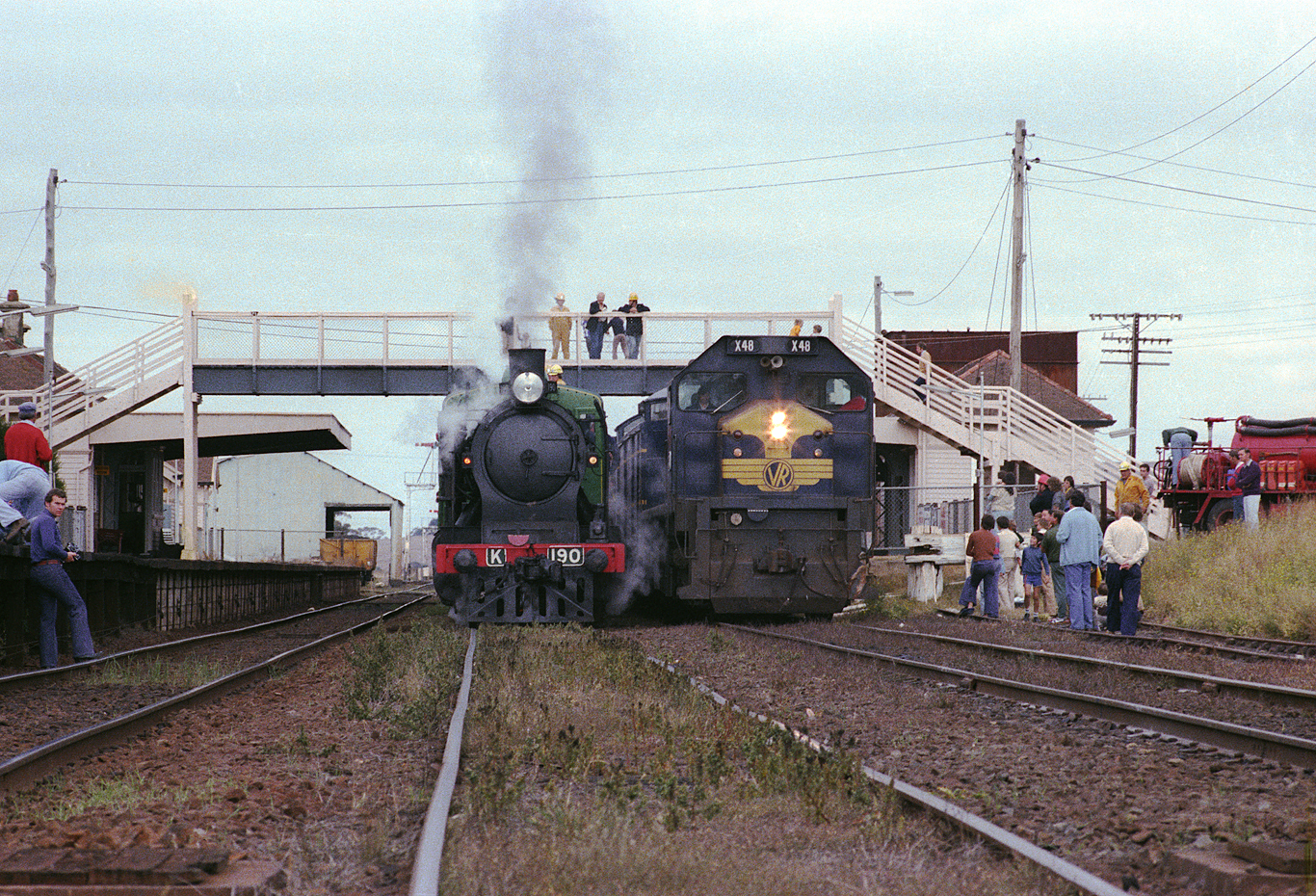
ABOVE & BELOW: X 48 on the Down "Great Northern Limited" runs through K 190 on an enthusiast special which is sitting in the centre
track at Sunbury. 1979.
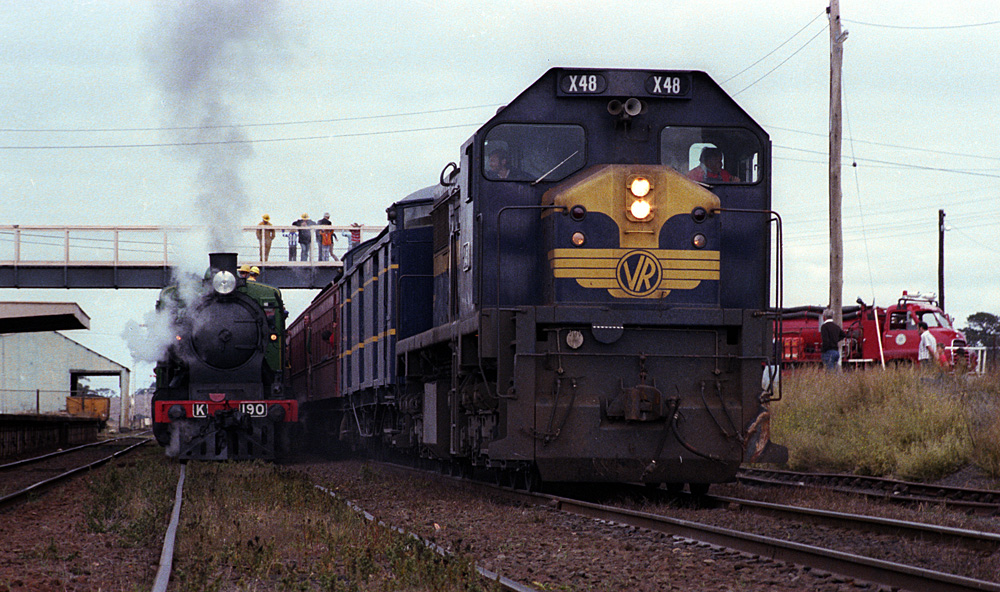
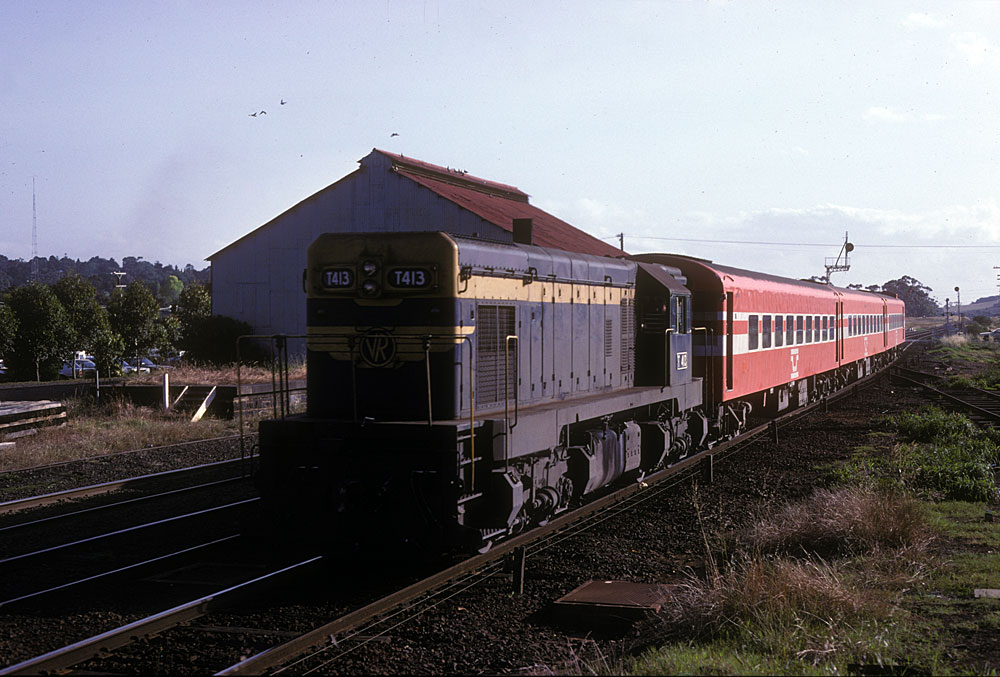
ABOVE: T 413 arrives at Sunbury on the 1745 Down Kyneton service, Dec. 15 1983 (photo courtesy Warren Banfield)
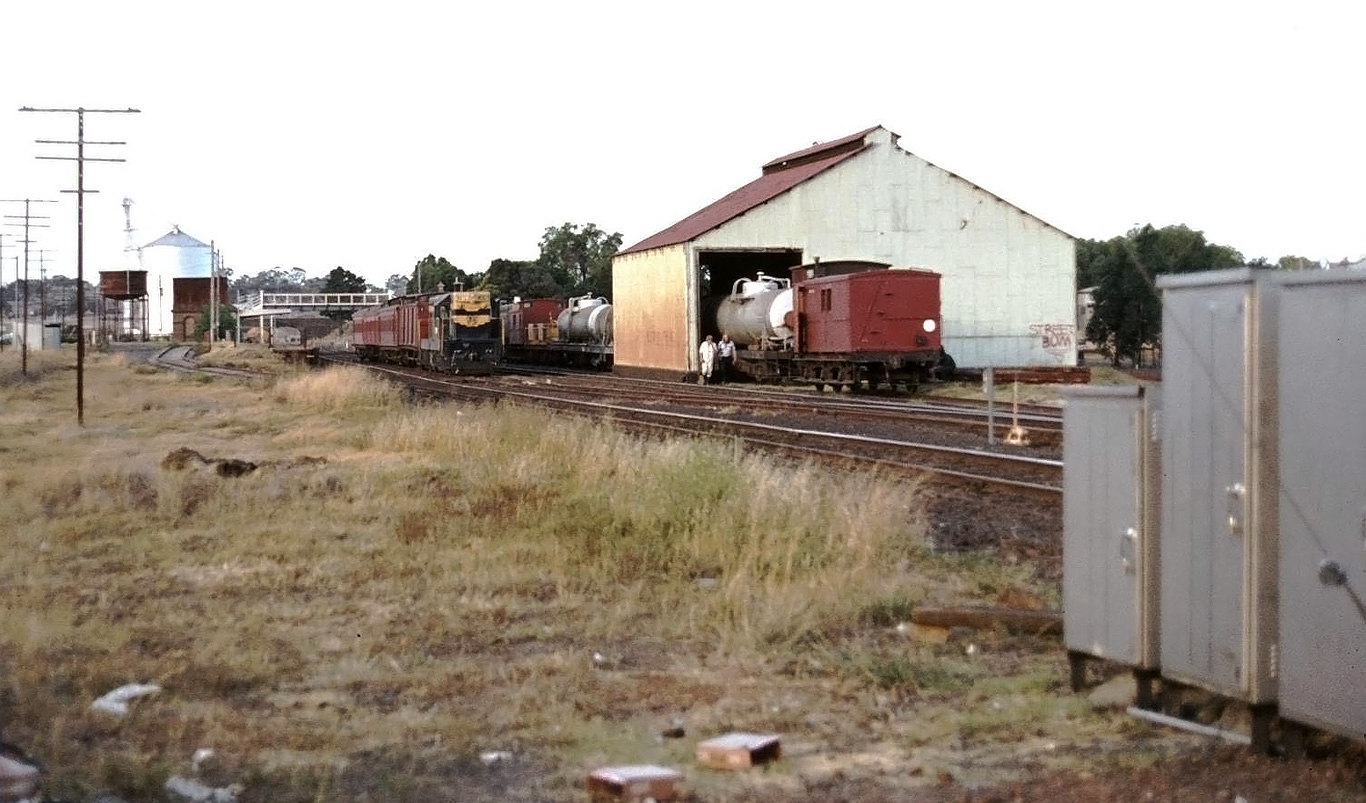
ABOVE: A flat top T departs Sunbury on an Up pass c1980, while the fire attack train sits in the goods shed road. This classic corrugated goods shed had an interesting history, it was originally built at Diggers Rest in July 1859. In Dec 1866 it was moved to Sunbury. It was demolished to make room for a commuter car park sometime in the 1990s, photo (photo courtesy Barry Cooper)
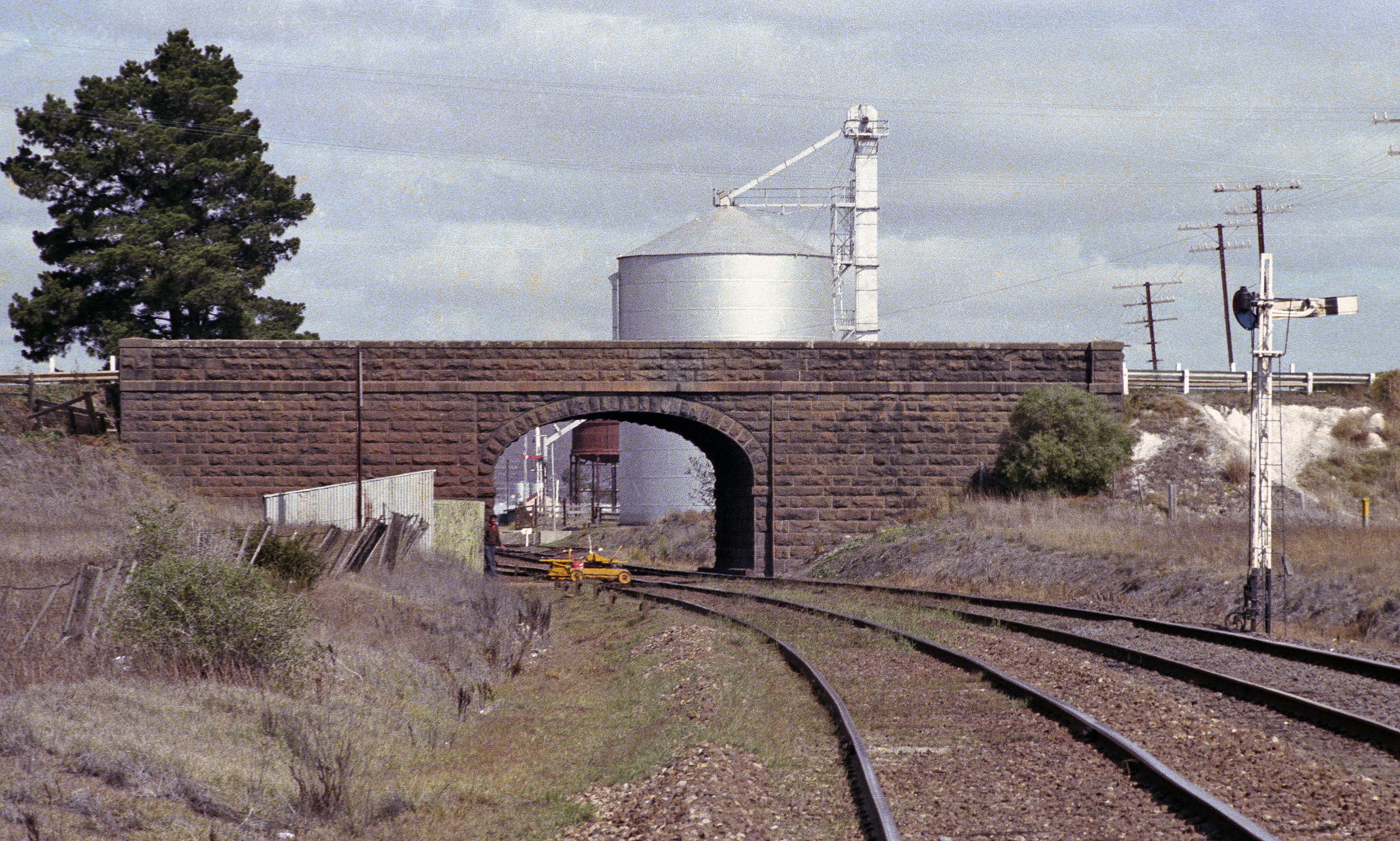
ABOVE: Looking south at the bluestone bridge carrying Macedon Street over the line. The grain bins went in the 1980s. The lower arm of the up home can be seen under bridge arch.The patrolman is seen getting his trolley out of the shed on the left. Feb 1980.
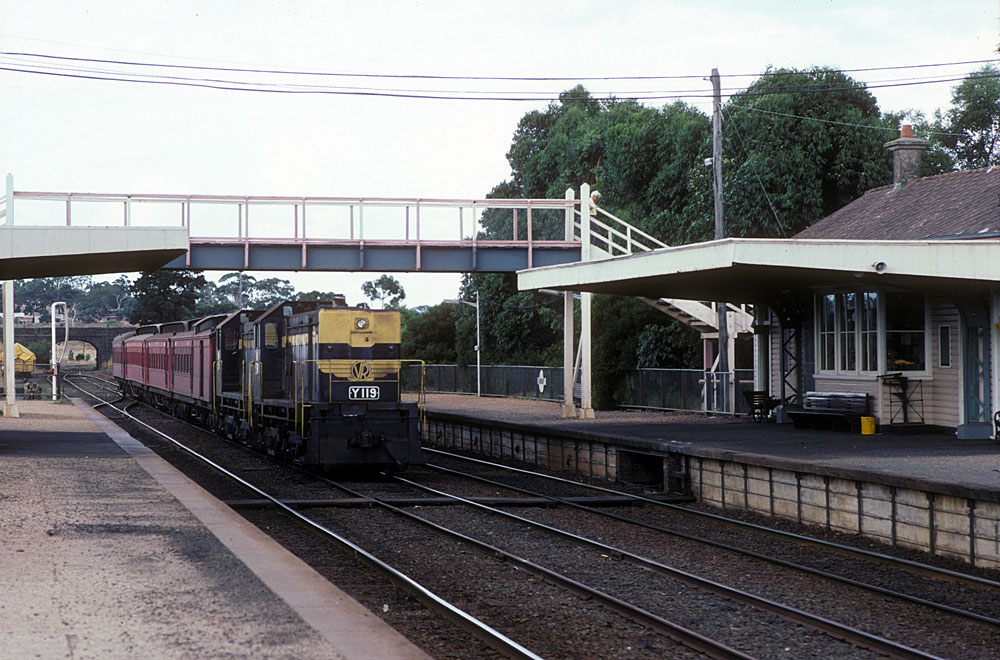
ABOVE: Y 119 and 108 in the centre road, probably running empty cars to Melbourne, Feb 15 1984 (photo courtesy Warren Banfield)
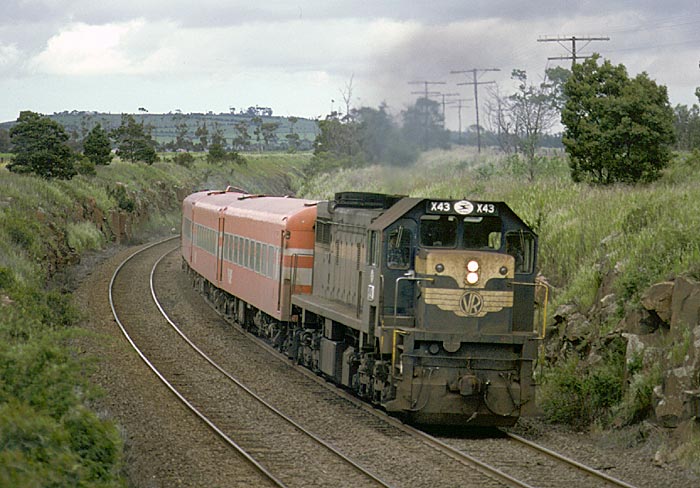
ABOVE: The "Great Northern Limited" races up Sunbury bank on its way to Bendigo, Oct. 25 1985
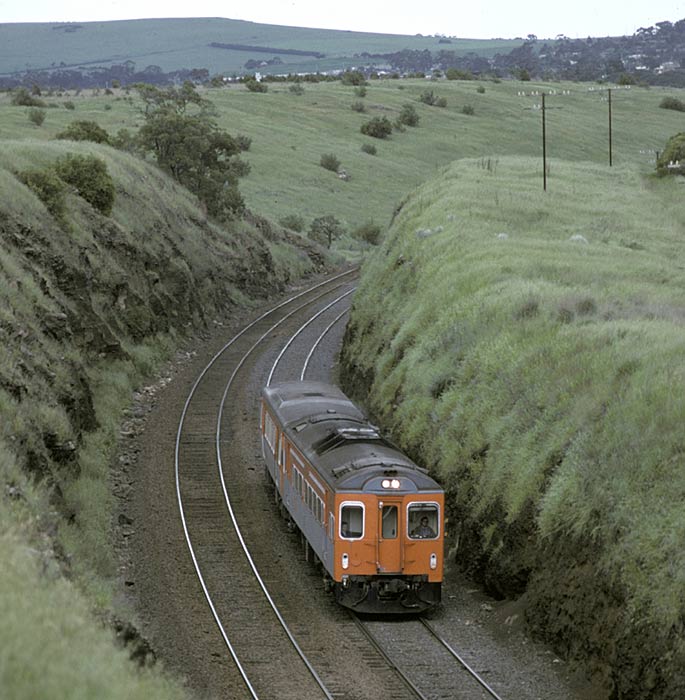
ABOVE: A DRC and trailer ascend Sunbury bank while running a Spencer St. to Kyneton service. Oct. 25 1985.
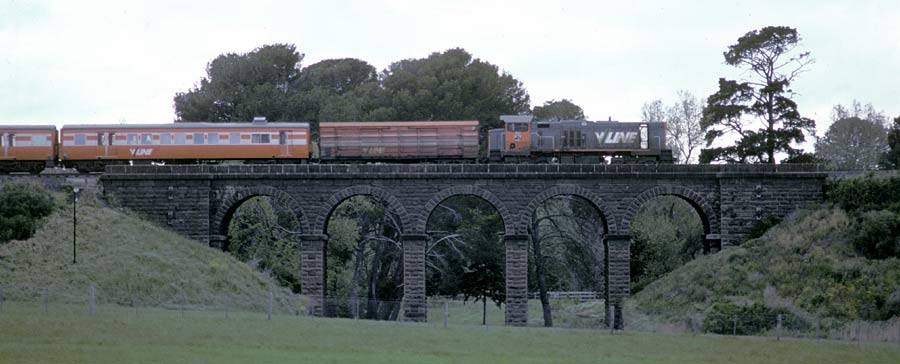
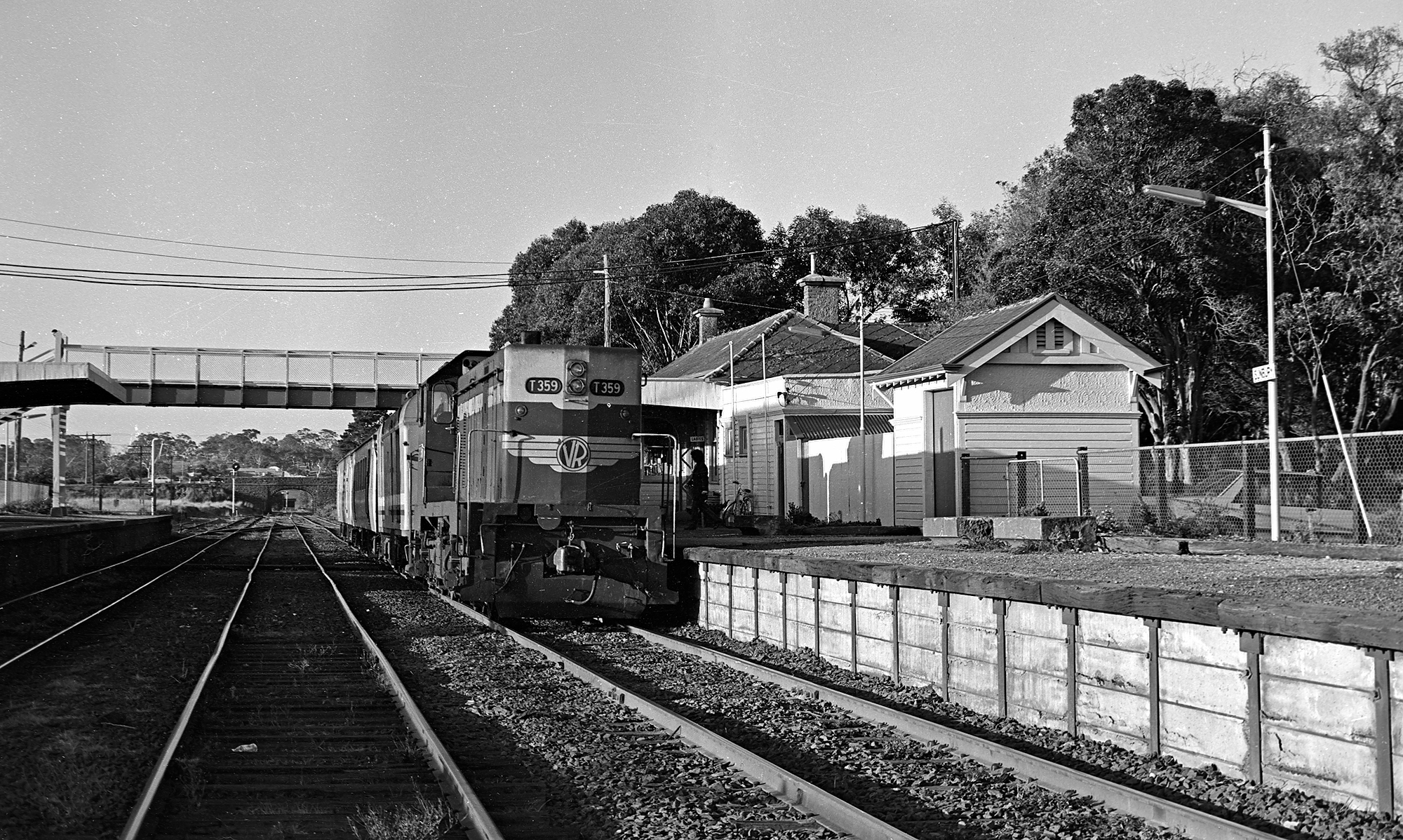
ABOVE: An Up afternoon Sunbury local awaits departure time for the journey back to Melbourne. 1988.
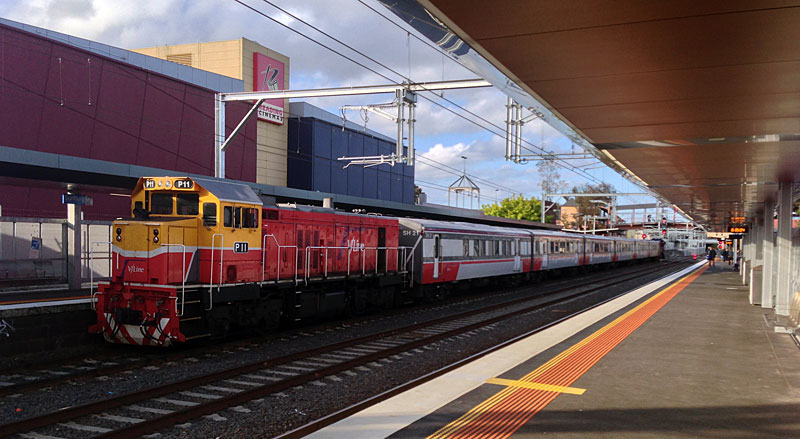
ABOVE: The last Sunbury local sits in the down platform prior to returning to Melbourne, Nov. 16 2012. Electric services commenced on Nov. 18 2012 thus removing the need for these loco hauled trains.
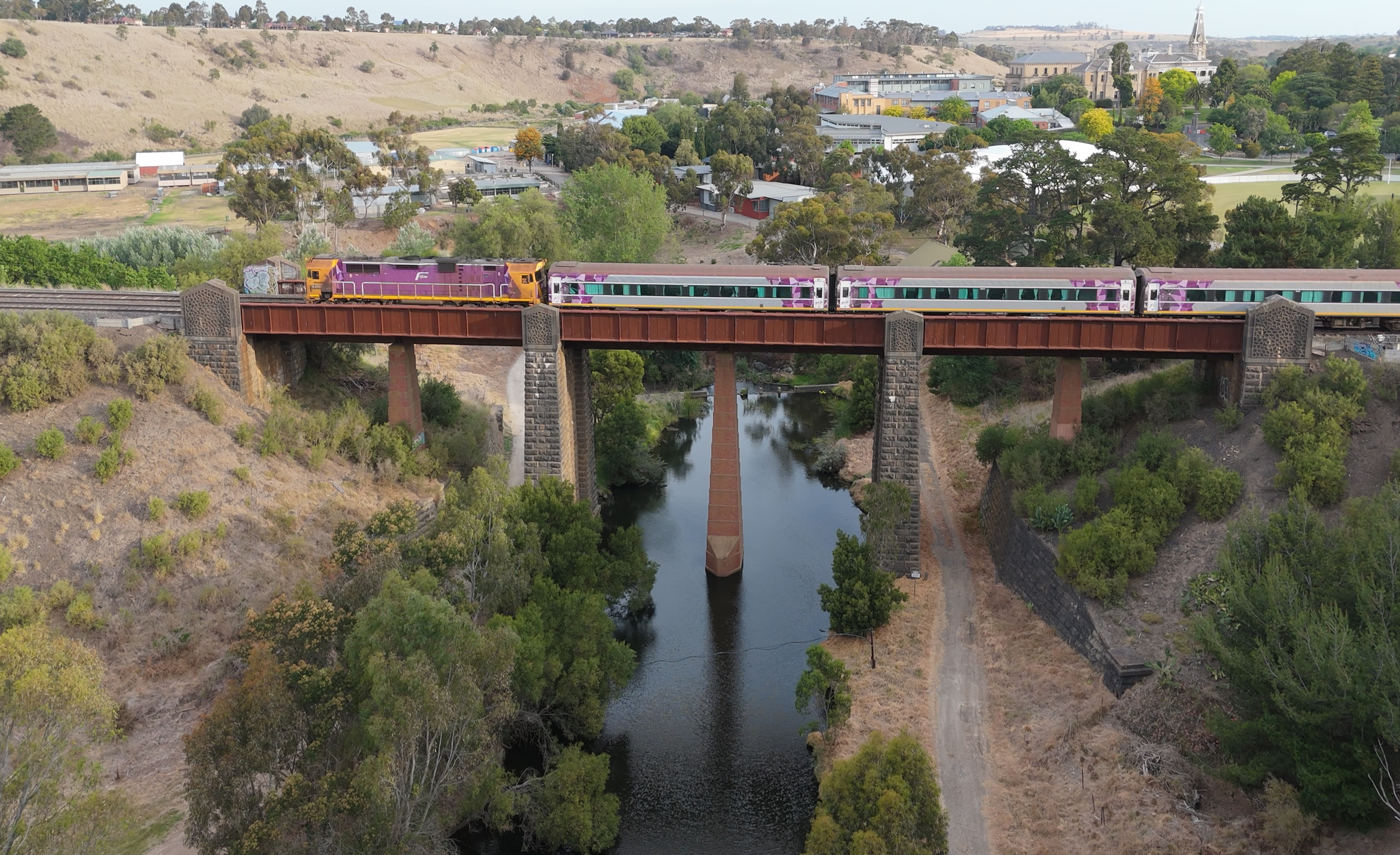
ABOVE: Drone photography has allowed views previously impossible to obtain. Here we see a down Swan Hill pass passing over the Jackson Creek viaduct just north of Rupertswood. Nov 2023.

RUPERTSWOOD
| Sunbury | 24Miles 38Chains ??Links / 39.???km | Clarkefield |
Rupertswood was a simple set of platforms sited adjacent to the property of the same
name, which is now the Salesian College. These platforms were opened sometime between 1909 and 1913.
The station was mainly used for picnics, which were held at the Rupertswood Mansion annually, up until the second world war.
The Up passenger platform was abolished on April 16, 1940.
After 1962, some regular services were stopped there in the weekday mornings and afternoons for use by students attending the college.
(Includes information from Andrew Waugh's 'Victorian Station Histories')
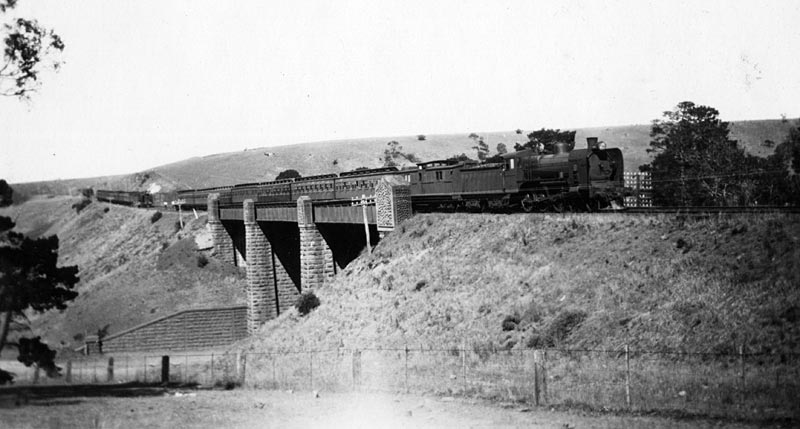
ABOVE: Three up special passenger trains at Rupertswood on the Down line, December 1938 at 3.00pm. The trains were at Rupertswood to take Catholic students back to Spencer Street after the Eucharist Festival at the nearby Salesian College. (Thanks to Peter Kelders for help with this caption)
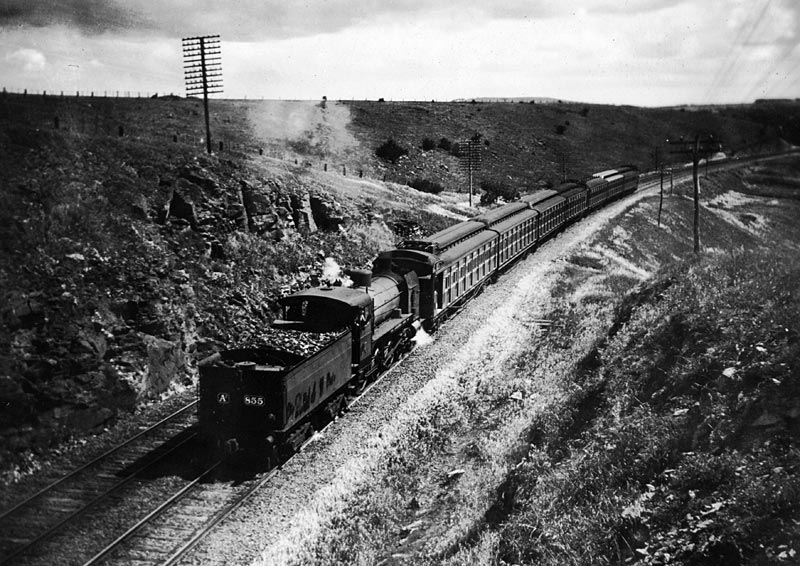
ABOVE: A2 855 is seen hauling a 7 car Tait train near Rupertswood for a Catholic festival special, Nov 3 1940
BELOW: This article is from the Sept. 1939 edition of "The Railway Magazine" and gives an excellent description of this operation by
well known VR rail enthusiast John Buckland.
(Thanks to Fraser Brown).
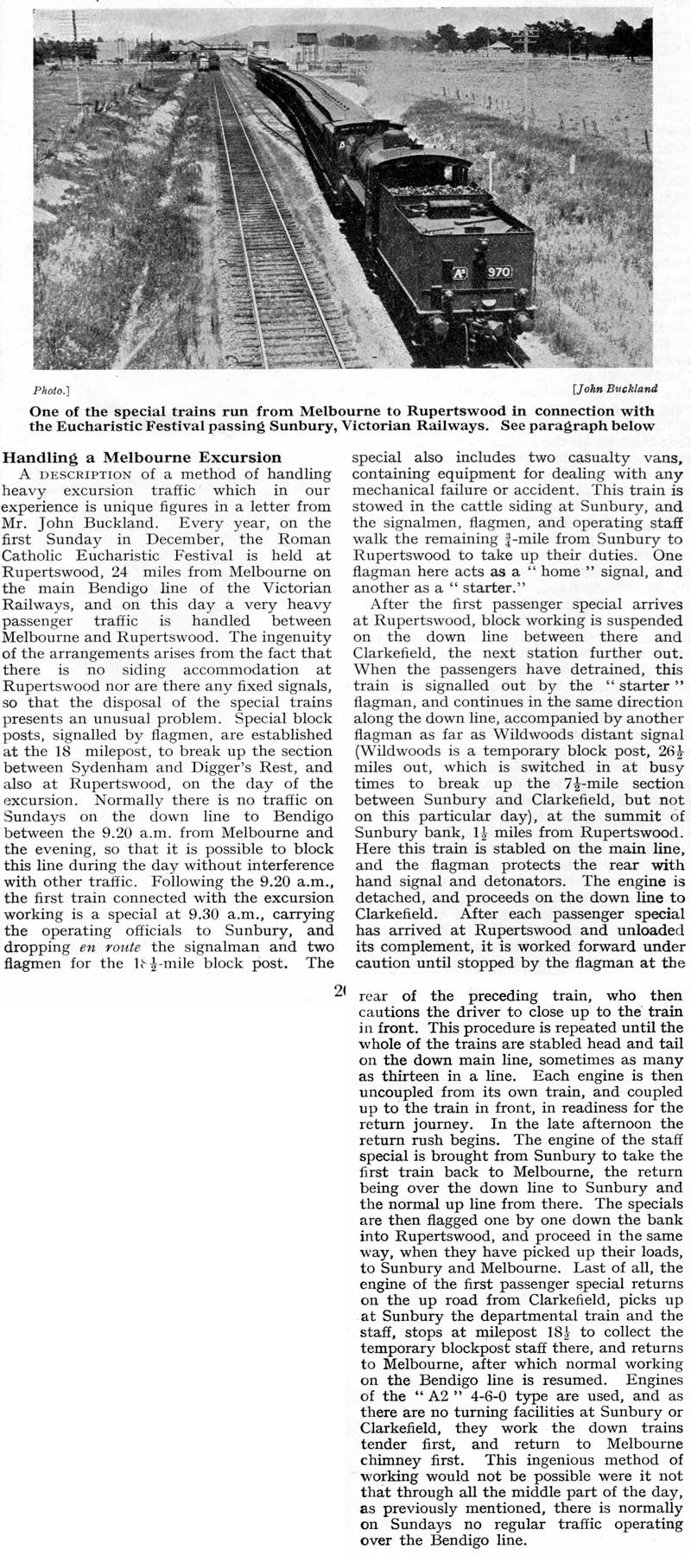
WILDWOODS Siding
| Sunbury | 26Miles 37Chains 20Links / 42.591km | Clarkefield |
For most of its life, Wildwoods was a special block post, which was only 'switched in' on special occasions; typically Foundation Day (January 31), Easter, and Christmas.
'Wildwoods Siding', as it was first known, opened sometime prior to May 1892 and had a crossover between the Up and Down main lines, which was removed in 1896. As per its name, it also had a siding which was sited on the Down (west) side of the line, with the points trailing from the Down main line. The 'Directory of Stations' does not list it as having any facilities, and it seems to have been removed by 1916.
On August 8, 1898, it was included in a list of locations where the signals were only in use on special occasions. Crosses were placed on the Up and Down Home signals.
On September 28, 1903, the trailing points on the Down main line, which formed Catch points, were altered to lie for the main line instead of the siding.
On July 17, 1912, Up and Down Distant signals were also provided. These were normally crossed along with the Home signals.
The location was renamed 'Wildwoods' on January 10, 1916, as the siding had been removed. From that date, for a period of 6 weeks, it was switched in daily, (except Sundays), at 06:00am. On February 21, 1916 it was again closed and all of the signals crossed.
On April 3, 1923, catch points were provided in the Down main line at 26 miles 44 chains. This was 200 feet ahead of the Down Home signal. These were removed on March 6, 1935.
The availability of 'switching in' of Wildwoods for the increase in traffic during busy holiday periods ceased on August 16, 1967. On that date, the Signals and block instruments were removed and the station was abolished. Prior to then, chains and padlocks had been provided to secure the signal quadrants at either the normal or reverse positions.
(Includes information from Andrew Waugh's 'Victorian Station Histories')
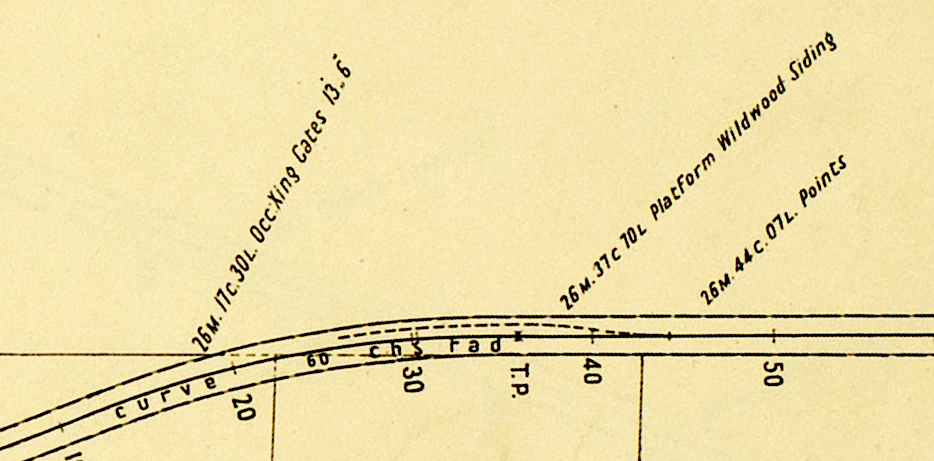
H.V. MCKAY Siding
| Sunbury | 27Miles ??Chains ??Links / 39.???km | Clarkefield |
The H.V. McKay siding opened for traffic on March 31, 1923, on the Down side of the line. Accessed via trailing points on the Down main line, the siding curved away to the west. A Down home signal was provided to protect the points, both of which were worked from 2 lever ground frame. This was secured by an Annett key, which was kept at Sunbury.
Operation of the siding transferred to a W. Naughton on August 14, 1928.
On October 4, 1937, the siding was abolished, The main line connection and the Down Home signal were removed.
(Includes information from Andrew Waugh's 'Victorian Station Histories')

Feel free to email me with any corrections or comments
Page modified Mar 07, 2022